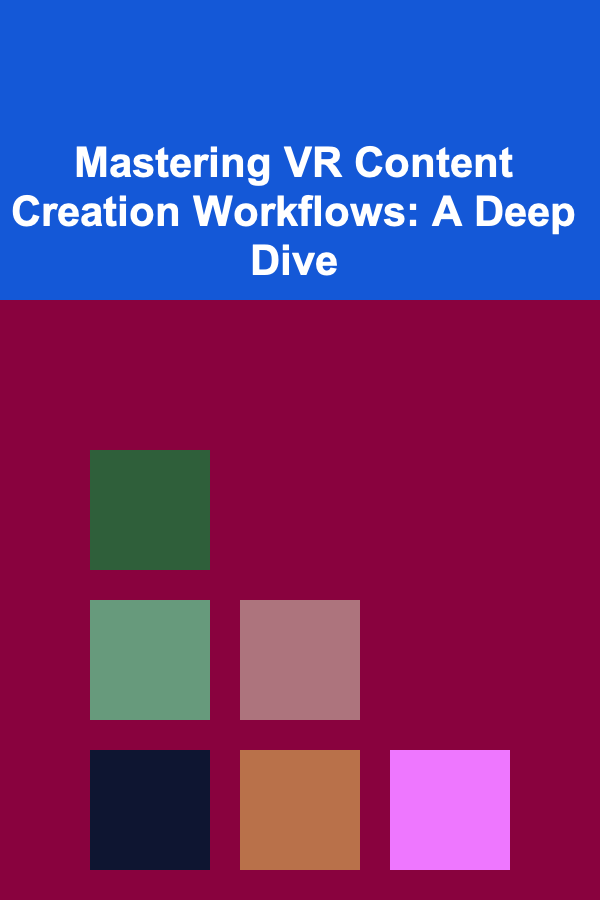
Mastering VR Content Creation Workflows: A Deep Dive
ebook include PDF & Audio bundle (Micro Guide)
$12.99$7.99
Limited Time Offer! Order within the next:

Virtual Reality (VR) content creation is a rapidly evolving field, offering immense potential for immersive experiences across entertainment, education, training, and beyond. However, the complexity of VR development requires a structured workflow and a deep understanding of its unique challenges and opportunities. This article provides a comprehensive guide to mastering VR content creation workflows, covering essential stages, tools, techniques, and best practices.
I. Understanding the VR Landscape
Before diving into the practical aspects, it's crucial to grasp the fundamental characteristics of VR and its implications for content creation.
A. The Core Principles of VR
- Immersion: The feeling of being present in a virtual environment. This is achieved through visual, auditory, and sometimes haptic feedback that isolates the user from the real world.
- Presence: The psychological sensation of "being there" within the VR environment. Presence is influenced by factors like realism, interactivity, and the user's suspension of disbelief.
- Interactivity: The ability to interact with the virtual environment and influence its behavior. Meaningful interactions enhance immersion and presence.
B. Unique Challenges of VR Content Creation
- Motion Sickness (VR Sickness): Discrepancies between visual and vestibular (inner ear) input can cause nausea and discomfort. Careful design considerations are needed to minimize motion sickness.
- Performance Optimization: VR experiences require high frame rates (typically 90Hz) to maintain a smooth and comfortable experience. Optimization is crucial to avoid performance bottlenecks.
- User Interface (UI) and User Experience (UX) Design: Traditional UI/UX principles don't always translate well to VR. New interaction paradigms and interface designs are required.
- Narrative Design: Storytelling in VR presents unique challenges and opportunities. Traditional cinematic techniques may need to be adapted or reimagined.
- Technical Complexity: VR development involves a complex ecosystem of hardware, software, and tools, requiring a diverse skillset.
II. The VR Content Creation Pipeline: A Step-by-Step Guide
A well-defined pipeline is essential for efficient and effective VR content creation. The following outlines a typical pipeline, highlighting key steps and considerations.
A. Conceptualization and Planning
This initial phase sets the foundation for the entire project. Careful planning is crucial to avoid costly mistakes later on.
- Define the Purpose and Target Audience: What is the goal of the VR experience? Who is it intended for? Understanding the purpose and audience will inform all subsequent design decisions. For example, a VR training simulation for surgeons will have very different requirements than a VR game.
- Develop a Concept Document: Outline the core idea, key features, target platform (e.g., Oculus, HTC Vive, mobile VR), and overall scope of the project.
- Create a Storyboard or Script (if applicable): For narrative-driven experiences, a storyboard or script is essential for visualizing the flow of events and interactions. Consider how the user will interact with the story and how their choices will impact the narrative.
- Define the User Journey: Map out the user's experience from start to finish, identifying key interactions and emotional touchpoints. This helps ensure a smooth and engaging user experience. Consider different user profiles and how they might interact with the experience.
- Conduct Research and Gather Inspiration: Explore existing VR experiences, games, and research papers to identify best practices and potential pitfalls. Analyze what works well and what doesn't.
- Technical Feasibility Assessment: Evaluate the technical feasibility of the concept. Are the desired features and interactions achievable within the available hardware and software limitations? Consider performance constraints and potential optimization challenges.
B. Prototyping and Iteration
Prototyping is crucial for testing and refining the core mechanics and interactions of the VR experience. Rapid iteration allows for early identification and resolution of potential issues.
- Create a Low-Fidelity Prototype: Use simple shapes, placeholders, and basic interactions to test the fundamental concepts. This can be done using game engines like Unity or Unreal Engine, or even simpler tools like VR sketching apps.
- Focus on Core Mechanics: Prioritize prototyping the most important interactions and features. Ensure they are intuitive, comfortable, and engaging.
- Test Early and Often: Gather feedback from target users throughout the prototyping process. Observe how they interact with the prototype and identify areas for improvement.
- Iterate Based on Feedback: Use the feedback to refine the prototype and address any issues or concerns. This iterative process is essential for creating a polished and user-friendly VR experience.
- Experiment with Different Interaction Methods: Explore different ways of interacting with the VR environment, such as hand tracking, voice control, or gaze-based interaction. Choose the interaction methods that are most appropriate for the specific experience.
C. 3D Modeling and Asset Creation
This phase involves creating the visual elements of the VR environment, including 3D models, textures, and animations.
- Choose the Right Modeling Software: Select a 3D modeling software that suits your needs and skillset. Popular options include Blender (free and open-source), Maya, 3ds Max, and ZBrush.
- Optimize for Performance: VR environments require highly optimized 3D models to maintain a smooth frame rate. Reduce polygon count, use efficient textures, and avoid unnecessary details. LOD (Level of Detail) techniques are critical here.
- Create Realistic Textures: High-quality textures can significantly enhance the visual fidelity of the VR environment. Use physically based rendering (PBR) materials to achieve realistic lighting and shading.
- Animate Characters and Objects: Bring the VR environment to life by animating characters and objects. Use motion capture or keyframe animation techniques to create realistic and believable movements.
- Consider Scale and Proportions: Pay close attention to the scale and proportions of objects in the VR environment. Ensure that they are consistent with the real world to avoid disorientation and discomfort.
- Use VR Preview Tools: Regularly preview your 3D models and animations in VR to ensure they look and feel as intended. This allows you to identify and address any issues early on. Tools like Oculus Mirror and SteamVR Mirror can be helpful.
D. Environment Design and Level Building
This stage focuses on creating the overall layout and atmosphere of the VR environment. Careful attention to detail is crucial for creating an immersive and believable experience.
- Plan the Layout: Carefully plan the layout of the VR environment, considering the user's movement and interaction patterns. Think about sightlines, navigation paths, and points of interest.
- Create a Sense of Scale and Depth: Use visual cues, such as perspective, lighting, and fog, to create a sense of scale and depth. This helps the user feel more immersed in the environment.
- Add Details and Polish: Populate the VR environment with details, such as foliage, props, and ambient sounds, to create a more immersive and believable experience.
- Optimize for Navigation: Ensure that the VR environment is easy to navigate. Use clear visual cues and intuitive movement controls to guide the user. Avoid creating confusing or disorienting layouts.
- Consider Lighting and Shadows: Lighting plays a crucial role in creating the atmosphere of the VR environment. Use lighting and shadows to highlight key areas and create a sense of depth.
- Use Environmental Storytelling: Use the environment to tell a story and provide context to the user. Place objects and details strategically to convey information and create a sense of history.
E. Interactivity and Programming
This phase involves adding interactivity to the VR environment and programming the logic that drives the experience.
- Choose a VR Development Platform: Select a VR development platform that suits your needs and skillset. Popular options include Unity, Unreal Engine, and A-Frame (for web-based VR).
- Implement Interaction Mechanics: Implement the interaction mechanics that were prototyped earlier in the development process. This includes hand tracking, object manipulation, and UI interactions.
- Program the Logic: Program the logic that drives the VR experience, such as game rules, narrative events, and AI behavior.
- Use Scripting Languages: Utilize scripting languages like C# (Unity) or Blueprint Visual Scripting (Unreal Engine) to create interactive elements and define the behavior of objects.
- Optimize for Performance: Optimize the code for performance to ensure a smooth frame rate. Avoid unnecessary calculations and use efficient data structures. Profiling tools are essential for identifying performance bottlenecks.
- Implement Error Handling: Implement robust error handling to prevent crashes and ensure a stable user experience.
F. Sound Design and Audio Implementation
Sound plays a crucial role in creating an immersive and believable VR experience. Spatial audio is particularly important for conveying the direction and distance of sounds.
- Create Immersive Soundscapes: Design immersive soundscapes that enhance the atmosphere of the VR environment. Use ambient sounds, sound effects, and music to create a sense of presence.
- Implement Spatial Audio: Implement spatial audio to create a realistic and believable soundscape. Use techniques like HRTF (Head-Related Transfer Function) to simulate the way sound is perceived in the real world.
- Synchronize Audio with Visuals: Synchronize audio with visuals to create a cohesive and immersive experience. Ensure that sound effects are timed correctly and that music matches the mood of the scene.
- Use Dynamic Audio: Use dynamic audio to react to the user's actions and the environment. For example, the volume of a sound effect might increase as the user gets closer to its source.
- Optimize for Performance: Optimize the audio for performance to avoid audio glitches and stuttering. Use compressed audio formats and avoid using too many audio sources simultaneously.
- Test with Headphones: Test the audio with headphones to ensure that it sounds as intended in VR. Headphones provide a more accurate representation of the spatial audio than speakers.
G. Testing and Quality Assurance
Thorough testing is essential for identifying and fixing bugs, ensuring a comfortable and engaging user experience, and optimizing performance.
- Conduct Usability Testing: Conduct usability testing with target users to identify any issues with the user interface, interaction mechanics, or navigation.
- Test for Motion Sickness: Test the VR experience for motion sickness. Identify any areas that might cause discomfort and adjust the design accordingly.
- Perform Performance Testing: Perform performance testing to ensure that the VR experience maintains a smooth frame rate. Identify any performance bottlenecks and optimize the code and assets.
- Test on Different Hardware: Test the VR experience on different hardware configurations to ensure that it runs smoothly on a variety of devices.
- Implement Bug Tracking: Implement a bug tracking system to track and manage bugs. Use tools like Jira or Trello to organize and prioritize bug fixes.
- Iterate Based on Testing: Use the results of the testing to refine the VR experience and address any issues or concerns.
H. Optimization and Deployment
This final phase involves optimizing the VR experience for performance and preparing it for deployment to the target platform.
- Optimize Assets: Optimize 3D models, textures, and audio files to reduce their size and improve performance.
- Optimize Code: Optimize the code to reduce CPU and GPU usage. Use profiling tools to identify performance bottlenecks and optimize the code accordingly.
- Optimize Lighting: Optimize the lighting to reduce the number of dynamic lights and shadows. Use baked lighting whenever possible.
- Reduce Draw Calls: Reduce the number of draw calls by combining meshes and using texture atlases.
- Test on Target Hardware: Test the VR experience on the target hardware to ensure that it runs smoothly and meets the performance requirements.
- Package and Deploy: Package the VR experience for deployment to the target platform. This involves creating a build that can be installed and run on the target device.
III. Essential Tools and Technologies
The VR content creation landscape is constantly evolving, with new tools and technologies emerging regularly. Here's an overview of some essential tools and technologies for VR development.
A. Game Engines
- Unity: A versatile and widely used game engine with excellent VR support. Unity offers a user-friendly interface, a vast asset store, and a strong community.
- Unreal Engine: A powerful game engine with advanced rendering capabilities and a visual scripting system (Blueprint). Unreal Engine is well-suited for creating high-fidelity VR experiences.
B. 3D Modeling Software
- Blender: A free and open-source 3D modeling software with a comprehensive feature set. Blender is a popular choice for both beginners and experienced 3D artists.
- Maya: An industry-standard 3D modeling software with advanced animation and rigging tools. Maya is widely used in the film and game industries.
- 3ds Max: Another industry-standard 3D modeling software with a focus on architectural visualization and design.
- ZBrush: A digital sculpting tool that allows artists to create highly detailed 3D models. ZBrush is often used for creating characters and organic shapes.
C. Audio Software
- Audacity: A free and open-source audio editing software that can be used for recording, editing, and mixing audio.
- Adobe Audition: A professional audio editing software with advanced features for sound design and audio restoration.
- FMOD Studio: A powerful audio engine that allows developers to create dynamic and interactive soundscapes.
- Wwise: Another popular audio engine with advanced features for spatial audio and interactive sound design.
D. VR Development Kits (SDKs)
- Oculus SDK: The official SDK for developing VR experiences for Oculus headsets.
- SteamVR SDK: The official SDK for developing VR experiences for HTC Vive and other SteamVR-compatible headsets.
- Google VR SDK: The official SDK for developing VR experiences for Google Cardboard and Google Daydream.
E. Version Control Systems
- Git: A distributed version control system that allows developers to track changes to their code and collaborate effectively. Services like GitHub, GitLab, and Bitbucket provide hosting for Git repositories.
IV. Best Practices for VR Content Creation
Adhering to best practices is crucial for creating comfortable, engaging, and effective VR experiences. Here are some key guidelines to keep in mind.
A. Prioritize User Comfort
- Minimize Motion Sickness: Avoid sudden camera movements, excessive acceleration, and conflicting visual and vestibular cues. Use techniques like virtual cockpits, vignetting, and controlled acceleration to reduce motion sickness.
- Maintain High Frame Rates: Aim for a consistent frame rate of 90Hz to minimize latency and reduce motion sickness.
- Provide Comfortable Interaction Methods: Choose interaction methods that are intuitive and comfortable for the user. Avoid forcing users to make unnatural or strenuous movements.
- Respect Personal Space: Be mindful of the user's personal space and avoid placing virtual objects too close to their face.
B. Design for Immersion
- Create Believable Environments: Pay attention to detail and create environments that feel realistic and believable. Use high-quality assets, realistic lighting, and immersive soundscapes.
- Tell Compelling Stories: If applicable, tell compelling stories that engage the user emotionally and intellectually. Use narrative techniques to create a sense of presence and immersion.
- Provide Meaningful Interactions: Allow the user to interact with the virtual environment in meaningful ways. This helps them feel more connected to the experience and enhances their sense of presence.
- Minimize Distractions: Minimize distractions and avoid breaking the user's immersion. Remove unnecessary UI elements and avoid using jarring transitions.
C. Optimize for Performance
- Optimize Assets: Use optimized 3D models, textures, and audio files to reduce their size and improve performance.
- Optimize Code: Write efficient code that minimizes CPU and GPU usage. Use profiling tools to identify performance bottlenecks and optimize the code accordingly.
- Use Level of Detail (LOD): Implement level of detail (LOD) techniques to reduce the polygon count of objects that are far away from the user.
- Bake Lighting: Bake lighting whenever possible to reduce the number of dynamic lights and shadows.
- Reduce Draw Calls: Reduce the number of draw calls by combining meshes and using texture atlases.
D. Iterate and Test Regularly
- Test Early and Often: Gather feedback from target users throughout the development process. Observe how they interact with the VR experience and identify areas for improvement.
- Iterate Based on Feedback: Use the feedback to refine the VR experience and address any issues or concerns.
- Conduct Usability Testing: Conduct usability testing to identify any issues with the user interface, interaction mechanics, or navigation.
- Test for Motion Sickness: Test the VR experience for motion sickness and adjust the design accordingly.
- Perform Performance Testing: Perform performance testing to ensure that the VR experience maintains a smooth frame rate.
V. The Future of VR Content Creation
VR content creation is a rapidly evolving field, with new technologies and trends emerging constantly. Here are some key areas to watch in the future:
- Advanced Tracking Technologies: Improved tracking technologies, such as eye tracking and full-body tracking, will enable more natural and intuitive interactions in VR.
- Cloud-Based VR: Cloud-based VR platforms will allow users to stream VR experiences to their devices, eliminating the need for high-end hardware.
- AI-Powered Content Creation: Artificial intelligence (AI) is being used to automate various aspects of VR content creation, such as 3D modeling, animation, and level design.
- Social VR: Social VR platforms are becoming increasingly popular, allowing users to connect and interact with each other in virtual environments.
- Metaverse Development: The development of the metaverse, a persistent and shared virtual world, is driving innovation in VR content creation and interaction.
Conclusion
Mastering VR content creation workflows requires a combination of technical skills, creative vision, and a deep understanding of the unique challenges and opportunities of the medium. By following the guidelines and best practices outlined in this article, you can create immersive, engaging, and effective VR experiences that push the boundaries of what's possible.

How to Brighten a Small Space with Strategic Lighting
Read More
How to Create Attractive Labels for Your Antique Collection
Read More
The Power of a Personal Brand: Tips for Job Seekers
Read More
How To Understand Cultural Approaches to Health and Wellness
Read More
Mastering the Wheelbarrow: A Comprehensive Guide to Hauling Materials Around Your Yard
Read More
How To Manage Your Job Search Time Effectively
Read MoreOther Products

How to Brighten a Small Space with Strategic Lighting
Read More
How to Create Attractive Labels for Your Antique Collection
Read More
The Power of a Personal Brand: Tips for Job Seekers
Read More
How To Understand Cultural Approaches to Health and Wellness
Read More
Mastering the Wheelbarrow: A Comprehensive Guide to Hauling Materials Around Your Yard
Read More